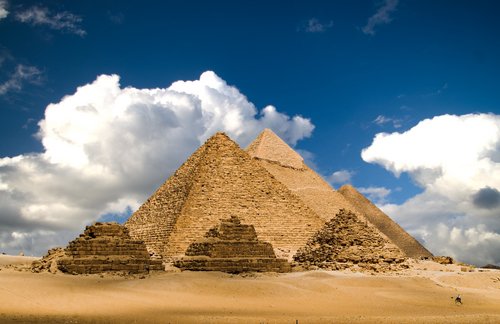[1] Hersey describes a grammar for Greek architectural elements based on the idea of sacrifice. SPECULATE about the validity of his argument based on what you know about Greek design and the evidence (both visual and written) he provides. (5 points)
I disagree with Hersey. I don’t think sacrifice plays a huge role in the design process. I do believe, however, that the design of the column is based on order and government. I do agree that it has a lot to do with the mythological belief system, but so does the Greek government system as a whole. The columns are tapered ever so slightly so that they point to the heavens, the temples and architectural elements were built to make us, as humans, seem more minuscule than the higher powers of the gods, goddesses, and the “higher-ups” in government.
[2] Meant in jest, Macaulay shapes a world of the future in which the main character claims meanings for archeological evidence uncovered at the Motel of the Mysteries. EXTRACT what you believe to be the lesson of mis-interpreting evidence and link that lesson to the real world phenomenon of the internet. In other words, EXPLAIN how you might avoid such a blunder as mis-reading evidence when you use the web as your major information source. (5 points)
Macaulay portrays the perfect example of people seeing one thing and automatically believing in it wholeheartedly. We do this everyday when we rely on the web for our resources. On the Internet, as noted in class, anyone can post whatever their heart desires and then it’s up there, without revisions, without any proof that the information is correct or legitimate. Books, however, are required to go through many people and many processes to test their validity. They are revised again and again to make sure that they are not false. To avoid ‘such a blunder as mis-reading evidence’…simply just go to the hardcopies! Go to the books. Because you know that information is true.
[3] The funerary temple design of Queen Hatshepsut speaks a very different design language than the pyramidal forms for other pharaohs. From your readings and the ideas addressed in class, RECOUNT possible reasons why Queen Hatshepsut used this building form. (5 points)
Queen Hatshepsut was the first woman to rule as pharaoh in the Egyptian society. The tombs of other pharaohs spoke of consistency and direction, pointing towards the heavens. Hatshepsut, however, kept hers low to the earth (in comparison to the traditional pyramids), and near the Valley of the Kings. Queen Hatshepsut altered the architecture of her time, just like she altered the government of the time, being the first woman pharaoh. She transposed her steak in history into her burial temple. Changing the minds of those around her and impacting the future that is to come.
[4] Although some evidence suggests links between the Egyptian and Greek civilizations, and some building forms and details provide support for that linkage, the two societies produced design responses in great contrast to one another. Select a building type (house, tomb, or temple) from each culture and ELUCIDATE similarities and differences in the two forms over time. Provide an annotated illustration for each selected type. (5 points)
Egyptian and Grecian architecture are two very different, yet very similar principles of styles. The Pyramids of Giza are symbols of status and perfection. They are the largest and grandest of the pyramids in Egypt. On the smaller scale… The Temple of Athena Nike at Acropolis is a tiny little punctuation mark on site. It’s one of the most perfect Ionic order structures. Like Giza, Nike is a lantern and a pinnacle for all to see. Both of their locations are important, as well. Giza is in the middle of the desert, all you see is the astonishing pyramids. But Nike is located on the edge of Acropolis, on the tip of a cliff. So although both of these styles are radically different, the point that is being made is relatively the same.
[5] Harwood shows examples of Egyptian furniture on pp. 60-61. HYPOTHESIZE about the lightweight nature of Egyptian furniture when compared to tomb architecture, as at the Pyramids of Giza, which many characterize as massive and heavy. (5 points)
This furniture shown is what lies in the tombs of the deceased. In the minds of the Egyptians, they believed that what was in their burial chambers, carried on with them into their afterlives. They wanted to bring their nicest, most decorative, and most ornate things with them into the afterlife, hence the lightweight feature of the furniture. The massive and heavy furniture, as described in the pyramids are not specified as ones personal objects. They are a part of the structure that has more permanence.
[6] Based on a careful reading of the visual evidence in these two images, DRAW OUT an explanation of design and gender roles as you see both depicted. As this language of urns represents essentially one of the main ways we know about Grecian culture, COMMENT on the validity of such a practice of reading evidence. (5 points)
Women played a more miniscule role in Grecian society. As you see on these urns, the men are sitting and the women are standing, serving to them. Even in the Greek architecture it is apparent, in structures like Erechteheion, where the women are literally holding up the building as columns and pointing you in the right direction. This plays as a metaphor that they are forever enslaved in pictorial form, or in stone, just as they would be in Grecian times.
http://www.treehugger.com/cornucopia-greek-urn-photo.jpg

http://knowledgebox.files.wordpress.com/2009/09/greekurn.jpg



[1]Good [2]Nice [3]Ok [4]Good observations [5]Good points [6]Nice tie in to architecture, but do you think this reading of the vases is a valid way to interpret ancient grecian culture?
ReplyDelete